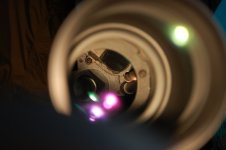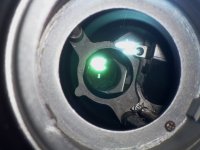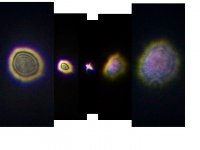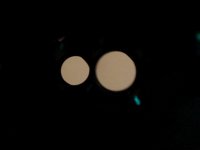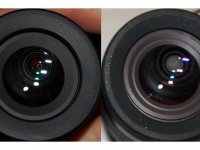I’ve had a busy week, so I’ve only just found the time to put together some images from the tests of the Vortex Razor I borrowed last week. The star-test composite photo on the left below gives some idea of the optical defects in the unit I borrowed. As usual, the photos are much less clear than what could be seen at the eyepiece. The left side of the composite is inside of focus. I didn’t quite succeed in making the photos symmetrical, so the extra-focal photos are about two rings more out of focus than the intra-focal photos.
This is certainly not the kind of star-test you want to see from your new $1600 telescope. There are indications of pinching (which causes The diffraction disks to be irregularly shaped), astigmatism (which causes the general elongation of the diffraction disk shapes) and coma (which causes the central spot of the diffraction disks to be off-center). Both the astigmatism and coma are visible in the (not quite perfectly) focused center image. Astigmatism causes the cross shape and coma causes the point where the cross bars meet to be off-center. These are all sample defects, which will vary with each specimen. The underlying spherical and chromatic aberrations, to the extent that you can see them through the defects, appear quite similar to the aberrations of the last Zen-Ray scope I tested here:
http://www.birdforum.net/showthread.php?t=202943
The combination of defects and aberrations in this particular Vortex scope results in rather poor optical performance. It’s difficult to measure the resolving power of an astigmatic scope using a bar target like the USAF 1951 Test Pattern because the horizontal and vertical bars can’t be focused simultaneously. My best guess is that the resolution of the Vortex is around 2.2-2.4 arc-seconds. That’s similar to the worst Zen-Ray specimen I tested. It’s about the equivalent of a diffraction limited 50mm scope, but the image quality of an aberration limited scope like this looks even worse at high magnification than it measures. The 60x image has a very soft gauzy appearance that a 50mm diffraction limited scope with the same resolving power wouldn’t have at the same magnification.
I think that’s enough about the optical defects of this unit. It’s clearly a lemon. I’m confident there are better specimens of the Razor, but it’s impossible to say how good the best ones might be. I believe the owner plans to return the scope, even though it’s already a year old. Vortex has a lifetime warranty, which certainly should cover optical defects like these, no matter when they’re discovered.
Once again, I have to repeat my familiar refrain - buyer beware! Birding scopes from every manufacturer are subject to wide sample variation. Never assume that a good review or a brand reputation makes you safe from a lemon or, much more likely, a mediocre unit. The problem virtually all scope buyers have, including the owner of this scope, is that we don’t come to the purchase with an inherent sense of what a telescope image should look like. Even bad scopes can produce images that look good at low magnification and, of course, all telescopes produce images that look bad at high magnification if the air is very unsteady. However, when I read of a “happy” owner who believes telescopes always become useless at 60x because of air turbulence, I strongly suspect that person owns a lemon and doesn’t know it.
Besides evaluating the optics my other purpose in borrowing this Vortex scope was to try to determine how much the Vortex and Zen-ray scopes are alike in design and fabrication details. The photos of the prism shelves that appeared earlier in this thread offer some good evidence that the scopes are probably not made in the same factory. Parts and finish are clearly different.
The optical designs may also be somewhat different, if Vortex marketing information is correct. The Vortex website says that the Razor uses a triplet objective. The Zen-Ray has a four element objective. I can see that the Vortex includes a singlet positioned near the prisms, similar to the one used in the Zen-Ray and also the Pentax 80mm scope, but it’s not clear to me whether that back element is considered part of the objective in the Vortex count. If it is, then the front group must be a doublet, like the Pentax. On the other hand, if it isn’t considered part of the objective then the front group must be a triplet like the Zen-Ray. Unfortunately, I only noticed the Vortex triplet description after I had returned the scope. While I had it I didn’t look at the front elements carefully enough to say whether they form a doublet or a triplet.
The middle photo below is a composite that shows the 20x exit pupil of the Vortex at infinity focus (right) and at close focus. The difference in size is caused both by an increase in magnification at close focus and by a gradual loss of clear aperture because the focusing prism acts as an aperture stop as it moves out of its optimum position at closer distances. I measured the Vortex clear aperture at about to 85mm at infinity focus and about 72-73mm at close focus. The loss of aperture follows the same pattern as the Zen-Ray, but since the actual clear aperture of the Vortex is always a few millimeters larger across the focusing range I think its prisms must be a little larger. Another bit of evidence for larger prisms is the absence of a prism edge impinging on the objective light cone in the star-test. That was clearly visible in star-tests of all three Zen-Rays I tested. This little bit of extra clear aperture probably makes no difference at all. I found no indication on the Vortex website that the Razor uses dielectric prism coating like Zen-Ray. If the Vortex coating is silver that would probably just about cancel any brightness advantage from the slightly larger aperture. The extra aperture is also unlikely to make any difference in resolving power since these are aberration limited scopes, not diffraction limited. The resolution of either scope will be dependent on the aberrations of a particular unit.
The right photo below shows the reflection pattern of my camera’s flash returning from the lens elements of the Vortex 20-60x zoom on the left and an earlier photo I made of the Swarovski 20-60x zoom on the right. I didn’t quite get the reflections in the Vortex photo perfectly lined up like the reflections in the Swarovski photo, but it should still be clear that these have the same design formula. Externally, the Vortex and Zen-Ray versions of this eyepiece design are not very similar as to parts and finish, but the lenses look identical. The Vortex zoom is another in a growing list of Asian sourced eyepieces that appear to be exact copies of the Swarovski zoom. I would be very surprised if the RSPB/Viking and Kite versions of this scope design don’t also use the Swarovski knock-off and I’ve noticed a couple of suspiciously similar looking astronomical zoom eyepieces which have the right focal length range. All of these scopes have bayonet mounts which closely resemble the Swarovski bayonet, but curiously, some of them, like the Vortex and apparently the RSPB, are modified just enough to make them incompatible with Swarovski eyepieces.
One final difference between the Vortex and Zen-Ray is possibly the country of origin. The Zen-Ray is acknowledged to be Chinese but the Vortex has a “Made In Japan” sticker attached to the mounting foot. That sticker may mean the scope is entirely Japanese or perhaps that just enough work is done in Japan for it to qualify for the sticker.




